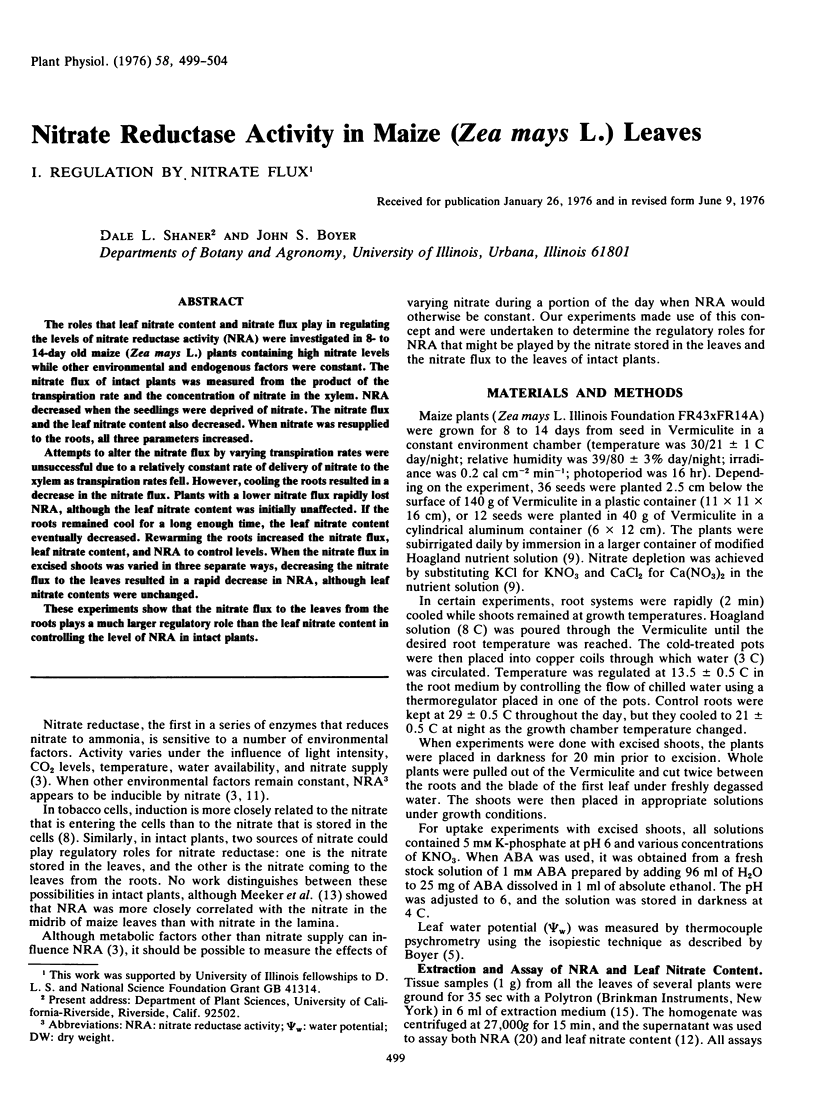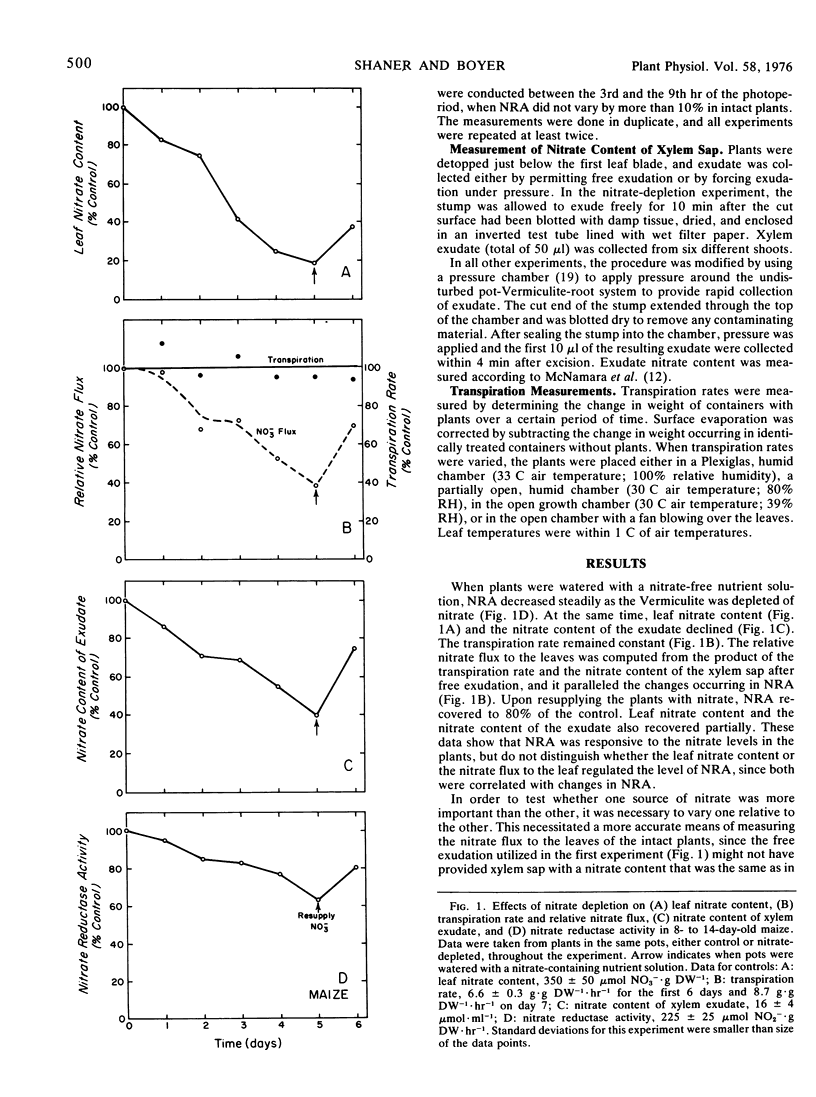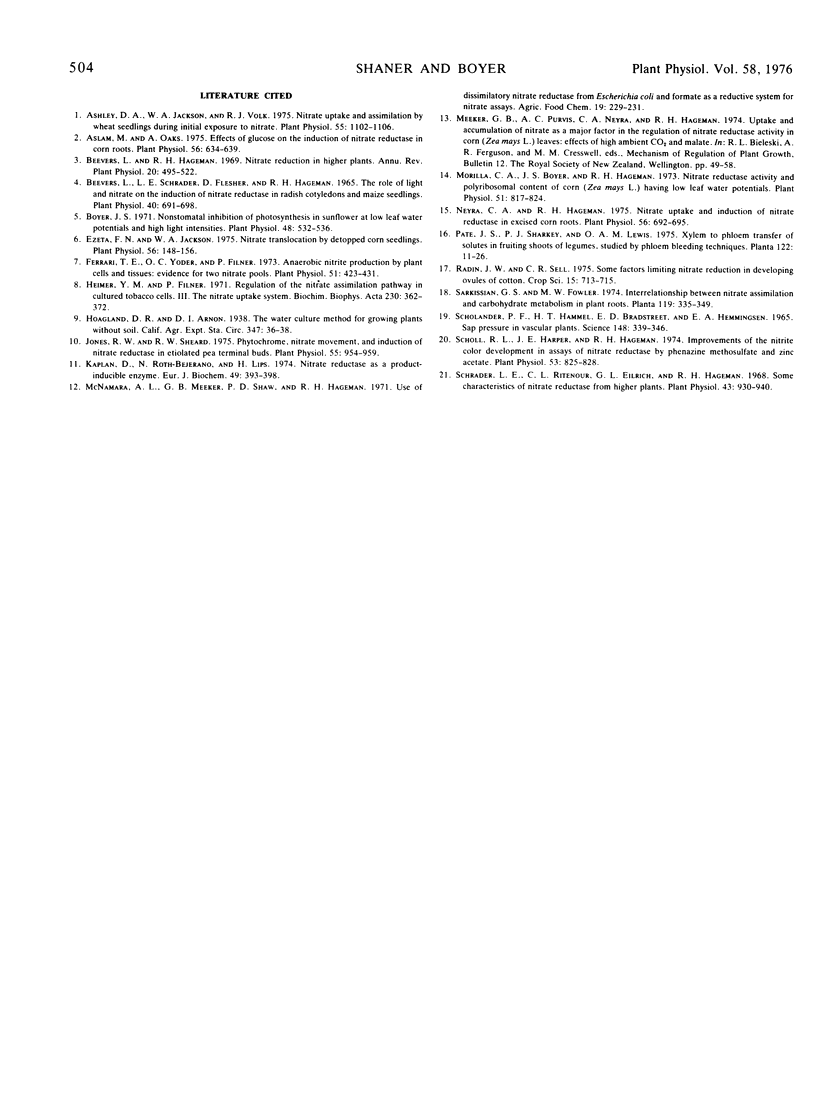Abstract
The roles that leaf nitrate content and nitrate flux play in regulating the levels of nitrate reductase activity (NRA) were investigated in 8- to 14-day old maize (Zea mays L.) plants containing high nitrate levels while other environmental and endogenous factors were constant. The nitrate flux of intact plants was measured from the product of the transpiration rate and the concentration of nitrate in the xylem. NRA decreased when the seedlings were deprived of nitrate. The nitrate flux and the leaf nitrate content also decreased. When nitrate was resupplied to the roots, all three parameters increased.
Attempts to alter the nitrate flux by varying transpiration rates were unsuccessful due to a relatively constant rate of delivery of nitrate to the xylem as transpiration rates fell. However, cooling the roots resulted in a decrease in the nitrate flux. Plants with a lower nitrate flux rapidly lost NRA, although the leaf nitrate content was initially unaffected. If the roots remained cool for a long enough time, the leaf nitrate content eventually decreased. Rewarming the roots increased the nitrate flux, leaf nitrate content, and NRA to control levels. When the nitrate flux in excised shoots was varied in three separate ways, decreasing the nitrate flux to the leaves resulted in a rapid decrease in NRA, although leaf nitrate contents were unchanged.
These experiments show that the nitrate flux to the leaves from the roots plays a much larger regulatory role than the leaf nitrate content in controlling the level of NRA in intact plants.
Full text
PDF





Selected References
These references are in PubMed. This may not be the complete list of references from this article.
- Ashley D. A., Jackson W. A., Volk R. J. Nitrate Uptake and Assimilation by Wheat Seedlings during Initial Exposure to Nitrate. Plant Physiol. 1975 Jun;55(6):1102–1106. doi: 10.1104/pp.55.6.1102. [DOI] [PMC free article] [PubMed] [Google Scholar]
- Aslam M., Oaks A. Effect of glucose on the induction of nitrate reductase in corn roots. Plant Physiol. 1975 Nov;56(5):634–639. doi: 10.1104/pp.56.5.634. [DOI] [PMC free article] [PubMed] [Google Scholar]
- Beevers L., Schrader L. E., Flesher D., Hageman R. H. The Role of Light and Nitrate in the Induction of Nitrate Reductase in Radish Cotyledons and Maize Seedlings. Plant Physiol. 1965 Jul;40(4):691–698. doi: 10.1104/pp.40.4.691. [DOI] [PMC free article] [PubMed] [Google Scholar]
- Boyer J. S. Nonstomatal inhibition of photosynthesis in sunflower at low leaf water potentials and high light intensities. Plant Physiol. 1971 Nov;48(5):532–536. doi: 10.1104/pp.48.5.532. [DOI] [PMC free article] [PubMed] [Google Scholar]
- Ezeta F. N., Jackson W. A. Nitrate translocation by detopped corn seedlings. Plant Physiol. 1975 Jul;56(1):148–156. doi: 10.1104/pp.56.1.148. [DOI] [PMC free article] [PubMed] [Google Scholar]
- Ferrari T. E., Yoder O. C., Filner P. Anaerobic nitrite production by plant cells and tissues: evidence for two nitrate pools. Plant Physiol. 1973 Mar;51(3):423–431. doi: 10.1104/pp.51.3.423. [DOI] [PMC free article] [PubMed] [Google Scholar]
- Heimer Y. M., Filner P. Regulation of the nitrate assimilation pathway in cultured tobacco cells. 3. The nitrate uptake system. Biochim Biophys Acta. 1971 Feb 23;230(2):362–372. doi: 10.1016/0304-4165(71)90223-6. [DOI] [PubMed] [Google Scholar]
- Jones R. W., Sheard R. W. Phytochrome, nitrate movement, and induction of nitrate reductase in etiolated pea terminal buds. Plant Physiol. 1975 Jun;55(6):954–959. doi: 10.1104/pp.55.6.954. [DOI] [PMC free article] [PubMed] [Google Scholar]
- Morilla C. A., Boyer J. S., Hageman R. H. Nitrate Reductase Activity and Polyribosomal Content of Corn (Zea mays L.) Having Low Leaf Water Potentials. Plant Physiol. 1973 May;51(5):817–824. doi: 10.1104/pp.51.5.817. [DOI] [PMC free article] [PubMed] [Google Scholar]
- Neyra C. A., Hageman R. H. Nitrate uptake and induction of nitrate reductase in excised corn roots. Plant Physiol. 1975 Nov;56(5):692–695. doi: 10.1104/pp.56.5.692. [DOI] [PMC free article] [PubMed] [Google Scholar]
- Scholander P. F., Bradstreet E. D., Hemmingsen E. A., Hammel H. T. Sap Pressure in Vascular Plants: Negative hydrostatic pressure can be measured in plants. Science. 1965 Apr 16;148(3668):339–346. doi: 10.1126/science.148.3668.339. [DOI] [PubMed] [Google Scholar]
- Scholl R. L., Harper J. E., Hageman R. H. Improvements of the nitrite color development in assays of nitrate reductase by phenazine methosulfate and zinc acetate. Plant Physiol. 1974 Jun;53(6):825–828. doi: 10.1104/pp.53.6.825. [DOI] [PMC free article] [PubMed] [Google Scholar]
- Schrader L. E., Ritenour G. L., Eilrich G. L., Hageman R. H. Some characteristics of nitrate reductase from higher plants. Plant Physiol. 1968 Jun;43(6):930–940. doi: 10.1104/pp.43.6.930. [DOI] [PMC free article] [PubMed] [Google Scholar]


